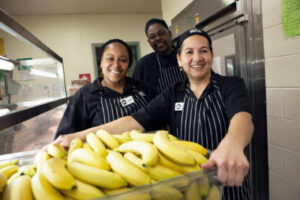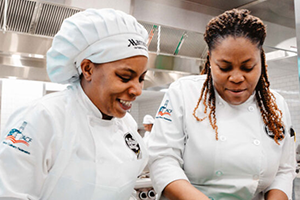It’s an age-old question that has puzzled parents and school officials alike: How do we get kids to eat more fruits and vegetables?
Since 2008, our Healthy School Food (HSF) program has served locally sourced, scratch-cooked meals to food insecure students across the district. With 18 DC school partnerships, our HSF team is always looking for fun, creative ways to encourage healthy eating habits for our students. As part of a two-year UnitedHealthcare grant, our HSF team partnered with American University’s Healthy Schools, Healthy Communities Lab (AU HSHC), led by Chair of the Department of Health Studies Dr. Stacey Snelling, to implement an intervention aimed at increasing our students’ consumption of fruits and vegetables during lunch time.
The COVID-19 pandemic has presented various challenges for students returning to in-person learning. One such challenge is ensuring students consume balanced, nutritious meals during lunchtime. As new research indicates that school meal programs provide students with their most nutritious meals of the day, it is essential that students receive ample opportunity to consume healthy foods during the school day.
With shortened lunch times due to social distancing protocols, some students now struggle to finish eating all the items on their plates. Less time for lunch means students may not eat their fruits and vegetables as they may prioritize “competing” foods on their plates. After observing lunchroom behaviors in 2021, the AU HSHC researchers saw an opportunity to partner with our HSF team to encourage healthy eating during the “down time” before lunch times.
“We wanted to look at small tweaks to the environment that could have big results in terms of fruits and vegetables consumption,” said Robin McClave, Research Director for the Healthy Schools, Healthy Communities Lab. The decision to tweak the lunchroom environment to maximize healthy eating opportunities led to an innovative appetizer approach.
Drawing on Nudge Theory, the HSHC team designed an intervention to encourage healthy eating behaviors by providing fresh fruit and vegetables on lunch tables for students to eat while waiting to receive their full lunch. The logic is simple: put a tray of cookies next to a platter of apples, and students are likely to choose the cookie before the apple. But by offering fresh fruits and vegetables as the sole “appetizer” before lunch, students are “nudged” to eat the healthy items before their meal.
“The notion that students may consume their fruits and vegetables more readily when they can eat them at the beginning of their lunch period is something our team may be able to capitalize on in schools. It could also allow us to introduce new fruits and vegetables to students and encourage more students to taste them before the lunch period instead of during,” remarked Samantha Reilly, DCCK Director of Contract Meals and Nutrition.
To test the appetizer approach, AU HSHC researchers and our HSF team decided to offer a fruit (banana) and a vegetable (baby carrots with dressing) as appetizers on lunch tables in two separate interventions at two DC public schools.
Prior to the appetizer intervention, only a handful of students ate half a banana with their meal during lunch. But when the banana was offered to students before they lined up to collect their lunch trays, the number of students consuming half a banana before their full meal nearly doubled. When our Healthy School Food team replicated this process using baby carrots, the students’ selection of carrots increased from 81.5% selecting carrots with their meal to 95.6% prior to the meal. That’s almost every student in the room.
As for consumption, the rate of students eating half of their carrots increased from 7.6% with the meal to 17.2% before the meal. The consumption rate for students eating all their carrots increased from 6.1% with the meal to 18.4% before the meal.
Notably, our team found less success when offering a whole banana as opposed to half a banana, and the lunchroom environment may influence consumption outcomes. “If students are not explicitly told that they can eat the fruit and vegetables on the lunch table, then they may not try it. There needs to be positive communication, preferably some form of encouragement, along with education and multiple exposures,” added Robin McClave.
While the results indicate that this appetizer approach may be an effective tool for increasing fruit and vegetable consumption in schools, the AU HSHC research team plans to expand the study by adding a third school this fall and considering new, creative strategies to determine “the most sustainable approach for food service staff that achieves the most impactful outcomes for students,” says Robin McClave.
As the school year starts back up, we look forward to continuing our partnership with the AU HSHC team and finding fresh, innovative ways to encourage healthy eating habits for our students!






